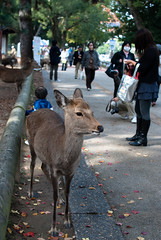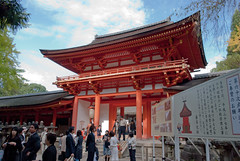This day we were heading out early to get more out of our Kansai Thru Pass. We weren't originally planning to head out to the city of Nara. However, since we had an extra day left on our Pass and since we had extended our stay an extra two days, we decided to make the most of it by visiting Nara and Uji.
That morning, we headed for breakfast at Matsuya again. I'm starting to tire of this fast food breakfast, but it is admittedly a quick and filling meal. Then we hopped onto the subway station for one stop to Namba station and then made a transfer to a Kintetsu train bound for Nara's Kintetsu station.
It still amazes me how close all these cities are. The ride to Nara was a very quick half-hour ride on a comfy Kintetsu train. It was a Sunday and the train was not any slower than any other day as far as I could tell. The Kintetsu to Nara runs mostly underground through Osaka, but it comes up to the surface in further reaches of the eastern part of town. Then it makes a turn northwards in a residential district as it scales up a hill towards a mountain tunnel. As the train briefly travels up the hill, you can look back at the towers of Osaka's city centre in the west. It looks pretty far away, but it's only been about 15 minutes from the time we boarded back at Namba.
The train made its way through the mountain range and exited on the other side. After being on this train for quite a while, I started to notice there were a lot of school age boys on the train this morning. Many of them were wearing the exact same athletic wear, which suggested to me that they were all from the same school. Station after station, a couple more boys with the same track suit would board the train. Plus, all of them were on their portable gaming systems. It made me wonder if they were already playing wirelessly with each other before meeting up on the train.

We arrived in the ancient city of Nara and made our way to the large giant city park just east of the Kintetsu Nara station. The very first thing we noticed were all the deer inhabiting the city. This must be the largest collection of semi-domesticated deer in the whole world. Obviously, being the good tourists we are, we took gobs of photos of the giant rodentia and even bought the deer snacks from the streetside vendors. These deer can be pretty aggressive. N had a few surrounding her and one or two nudging her from behind. Thankfully, it looks like all the deer have their horns trimmed right down to prevent unnecessary gouging.
We kept walking deeper and deeper into the park and there were more and more deer everywhere. There were sleepy deer who must have had enough food from tourists for the day. There were deer standing in the middle of the road waiting for cyclists and vehicles to go around them. There was one deer lapping up water in a tiny stream by one of the temples. Then my favourite deer of all was the iron-deficient deer who was chewing on the tough metal chain-links of a fence. Mmm...tasty...
Our first big destination of the day was Todai-ji [
東大寺]. This is the largest wooden structure in the world which also houses the largest statue of Buddha. What is even more amazing is that the temple is only a reconstruction of what was an even larger original wooden structure. The current great hall of Todai-ji is actually 30% smaller than its predecessor! The original building must have been even more impressive.

Just behind the giant Buddha statue is a giant wooden column with a hole at the bottom. The hole is apparently the same size as Buddha's nostril. Apparently, the belief is that those who can squeeze through this hole, a representation of Buddha's nostril, then you will attain enlightenment. Well, we came all this way, so we couldn't pass up this opportunity. However, it was a lot more fun to watch people trying to squeeze through than it was actually doing it. I actually had to go through twice because N's camera didn't work the first time around so I lined up again. Does that make me doubly enlightened or did the second time around nullify my enlightenment?
What was even more fun was a Japanese motorcyclists who tried to squeeze through. First of all, he was still wearing his bulking riding pants complete with buckles. Second, it looked like he had contorted his body the wrong way in order to pass through. My, was he ever stuck in that hole or what? A tourist complete with netbook and webcam saw the proceedings and recorded everything directly onto his hard drive. I don't think the guy ever made in the end after two attempts. To add salt to his wounded pride, a little kid went right after him with no difficulty whatsoever. Everyone had a good laugh at the biker's expense.
After Todai-ji, we walked a long walk towards Kasuga Taisha [
春日大社]. This is probably the most important Shinto shrine in Nara. It was really busy this Sunday because many families had brought their children for the 3-5-7 celebrations. So many well dressed families in Western and traditional garb. Some of the kids' clothing were hybrid traditional Japanese and Western dress. We thought about exploring the deep interior of this shrine, but decided against it when we saw the crowds and thought it was enough to just see the outside and part of entrance area. It was just fun people watching Japanese families during this time of ritual.

We head back down towards the train station, but not before passing through a lane lined with stone lanterns on either side. Many a deer were poking their heads out in between the lanterns. Cute little rascals when they leave me alone. I guess as long as I'm not feeding them, I'm not getting tugged on and nudged at. The stone lanterns were quite impressive and some of them had characters engraved on them. I got the impression that the characters were usually the names of people who had perhaps donated to erecting these stone lanterns. I think a few of the lanterns even had corporate sponsors from the looks of it.

We took a different road back to the train station and happened upon a little market area. I suspect we had come across the northern section of the Naramachi shopping area. There were a lot of folks milling about on this Sunday morning. So we could resist grabbing a little something to eat while in this area. We lined up for a little green tea mochi snack with a peanut type powder sprinkled over it. Tasty little treat to hit the spot for our next leg of travel. It wasn't quite lunch time yet so we thought we would wait until Uji before eating. You'll find out why maybe we should ate first in our next post. Mostly H's fault this time.












